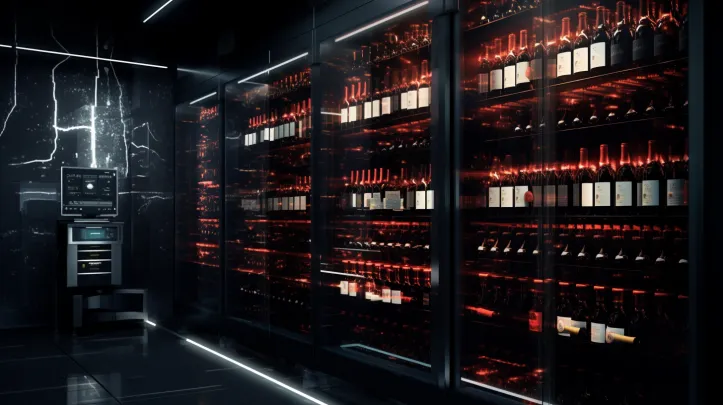Table of Contents
AI-powered wine apps, such as Vivino and Hello Vino, aid enthusiasts in choosing the ideal bottle. Researchers elevate this with AI wine-tasting algorithms, integrating flavor impressions from tastings, labels, and reviews. This innovation could transform selecting wines, beer, coffee, and personalized food recommendations.
Navigating the wine aisle proves daunting for novices, facing unfamiliar labels. Questions arise: What’s the taste? Which was that delightful one? AI wine tasting offers a solution.
Discover the power of AI wine tasting through apps like Vivino, Hello Vino, and Wine Searcher. These tools enable label scanning, providing details, and reviews, all powered by intelligent algorithms.
Researchers from DTU, the University of Copenhagen, and Caltech unveil a breakthrough in AI wine-tasting. By integrating people’s flavor impressions, they expand algorithms to precisely match individual taste preferences. This collaborative effort introduces a pivotal parameter, enhancing algorithmic accuracy for personalized wine selection. The inclusion of human flavor perceptions revolutionizes the framework, offering a nuanced understanding of taste. Their innovation signifies a significant stride in AI-driven wine-tasting technology, merging scientific precision with subjective human experiences to refine the selection process. This pioneering approach reshapes how AI comprehends taste, amplifying its capacity to cater to individual palates in the realm of wine selection.

Thoranna Bender, a graduate student at DTU, conducted an impactful study within the Pioneer Centre for AI at the University of Copenhagen, showcasing the efficacy of AI in wine tasting. By inputting people’s flavor impressions into the algorithm, Bender’s research highlighted its ability to predict individual wine preferences more accurately. This groundbreaking demonstration unveils AI’s potential to revolutionize the wine selection process, offering personalized and precise recommendations based on individuals’ taste profiles. Bender’s study signifies a pivotal stride in harnessing AI’s capabilities within the realm of wine tasting, promising enhanced and tailored experiences for wine enthusiasts and consumers alike.
AI Wine-Tasting Predictions
During AI wine tastings, 256 participants arranged wine samples on paper based on taste similarity. The greater the cup distance, the more distinct the flavor. This method, common in consumer tests, helped researchers digitize paper points through photography for analysis. This innovative approach advances understanding through AI in wine-tasting assessments.
The AI wine-tasting project merged tasting data with vast wine labels and user reviews from Vivino. Researchers utilized this extensive dataset to craft an advanced algorithm, refining wine selections based on taste preferences and user insights, harnessing Vivino’s global app and marketplace data for comprehensive analysis and algorithm development.
Thoranna Bender explains that the flavor dimension in their model offers insights into wine similarities. Using AI wine-tasting, one can easily identify similar wines in taste or both taste and price. For instance, by leveraging this model, Bender mentions the ability to find wines akin to personal favorites, simplifying the selection process based on taste preferences and budget considerations.
Serge Belongie, leading the AI wine-tasting research at the University of Copenhagen’s Pioneer Centre for AI, notes the algorithm’s enhanced accuracy in predicting wine preferences. By amalgamating data from labels, reviews, and tastings, the algorithm outperforms traditional methods, underscoring the advantage of incorporating human sensory experiences for superior user benefits.
Can be used for beer and coffee
In the realm of AI wine-tasting, Serge Belongie notes a rising trend in machine learning: the utilization of multimodal data, often blending images, text, and sound. Incorporating taste and sensory inputs marks an innovative frontier with vast potential, especially in industries like food. Belongie highlights this groundbreaking approach.
“AI-wine tasting remains nascent in food science. This project highlights human-based inputs powering AI. It promises to drive further research in the food science-AI nexus for enhanced taste understanding in sustainable food production.”
The researchers’ methodology, as pointed out by Thoranna Bender, can be smoothly extended to other varieties of food and drink.
Wine has been selected as an example, however, the identical approach can easily be extended to encompass beer and coffee. One example is platforms like Beerwulf, which curate and deliver diverse selections of beer, making them ideal candidates for integrating AI-driven personalization. This methodology can be employed to suggest products and potentially even culinary recipes to individuals. Moreover, by comprehending the taste resemblances in food, we can utilize this technique in the healthcare industry to create meals that align with the preferences and nutritional requirements of patients. Furthermore, it could even be utilized to formulate customized food options for diverse taste preferences.
The data published by the researchers is available for free on an open server.
Thoranna Bender concludes by expressing hope that someone will be interested in expanding upon their data. She mentions that they have already received requests from individuals who possess additional data that they would like to contribute to their dataset. Thoranna finds this prospect to be quite fascinating and exciting.